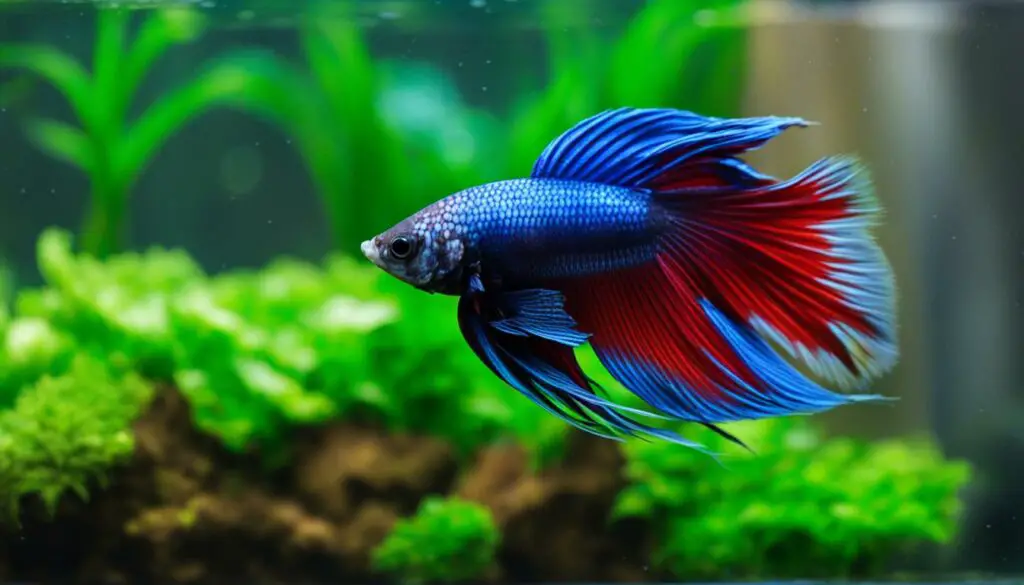Last Updated on 2 years by admin
As a betta fish owner, it’s essential to know how to identify and treat fin rot, as it can have severe consequences for your fish’s health. Fin rot is a condition caused by bacterial infection, which can lead to the degradation of your betta fish’s fins and even death if left untreated.
In this guide, we will provide you with step-by-step instructions on how to effectively treat fin rot in betta fish. We will cover various treatment options, remedies, and care tips to help your betta fish recover from fin rot and maintain their overall health and well-being.
Key Takeaways
- Fin rot is a bacterial infection that can damage your betta fish’s fins and pose a significant health risk.
- Treatment options for fin rot include natural remedies, medication, and surgical intervention in extreme cases.
- Proper care practices, such as water quality management and nutrition, can aid in the recovery of betta fish with fin rot.
- Prevention is crucial in minimizing the risk of your betta fish developing fin rot.
- Regular monitoring and follow-up care are essential to ensure the effectiveness of the chosen treatment method and maintain your betta fish’s health.
Understanding Fin Rot in Betta Fish
As a betta fish owner, it’s important to know how to identify and treat fin rot, a common and potentially serious condition that affects these beautiful creatures. Fin rot is a bacterial infection that affects the fins and tail of betta fish, causing them to deteriorate and fray over time. If left untreated, fin rot can lead to further health complications and even death.
Causes of Fin Rot
Fin rot can be caused by several factors, including poor water quality, stressful conditions, physical injury, or exposure to parasites. In most cases, the bacteria responsible for fin rot are naturally present in aquarium water and can infect a fish through small injuries or weak immune systems.
Symptoms of Fin Rot
The symptoms of fin rot vary depending on the severity of the infection. In the early stages, you may notice slight discoloration or fraying at the edges of the fins. As the infection progresses, the fins may become shorter and more ragged, and the fish may exhibit other signs of illness such as lethargy and loss of appetite. In severe cases, the infection can extend to other parts of the fish’s body, causing more serious health problems.
Treatment for Fin Rot
Early detection and treatment are crucial to successfully treating fin rot in betta fish. Treatment options vary depending on the severity of the infection. In mild cases, simple changes to water quality and diet may be enough to help the fish recover. In more severe cases, medication or surgical intervention may be necessary.
Preventing Fin Rot
Prevention is key when it comes to fin rot. To prevent the occurrence of fin rot, it’s important to maintain clean water conditions and reduce stress in your fish. This can be achieved through regular water changes, maintaining appropriate water temperature and pH levels, and providing plenty of hiding places and healthy nutrition for your fish.
By understanding fin rot in betta fish, you can take the necessary steps to prevent, identify, and treat this condition effectively. In the next section, we will discuss how to identify fin rot in your betta fish and differentiate it from other similar conditions.

Identifying Fin Rot in Betta Fish
Properly identifying fin rot is crucial for initiating the right treatment. Fin rot is a disease that affects a betta fish’s fins and can quickly spread to the rest of their body. Betta fish with fin rot will have ragged or frayed fins and may appear discolored. It’s important to differentiate fin rot from other conditions like physical fin damage or fungal infections.
Here are some visual signs and symptoms to look out for when identifying fin rot in betta fish:
| Signs of Fin Rot | Symptoms |
|---|---|
| Discolored or opaque fins | Betta fish with fin rot may have white or black edges on their fins. They may also appear opaque or milky in color. |
| Frayed or ragged fins | Betta fish with fin rot will often have fins that look torn or frayed at the edges. The fins may appear uneven in length or have holes. |
| Shortened fins | Over time, the fins of betta fish with fin rot may become shorter and stubby. This is due to the disease attacking the fin rays and causing them to break down. |
| Behavioral changes | Betta fish with fin rot may become less active or show signs of lethargy. They may also hide more often or lose their appetite. |
If you notice any of these symptoms in your betta fish, it’s best to take action as soon as possible to prevent the condition from worsening. Proper treatment and care can help your betta fish recover from fin rot and maintain their overall health and well-being.
Preventing Fin Rot in Betta Fish
Betta fish are incredibly susceptible to fin rot, but there are numerous steps you can take to prevent it from occurring. By following these preventive measures, you can maintain your betta fish’s health and minimize the risk of developing fin rot.
1. Maintain Clean Water Conditions
Regular water changes are essential for maintaining clean water conditions in your betta fish’s tank. Ensure you have a good filter and perform a 25% water change weekly, or a 50% water change every two weeks. This will help keep the water clean, clear, and free from harmful bacteria.
2. Provide a Balanced Diet
Betta fish require a balanced diet to maintain good health and immune function. Provide a high-quality pellet food that meets their dietary needs and feed them small quantities twice a day. Avoid overfeeding, which can result in food waste and excess nutrients that can lead to poor water quality and bacterial infections.
3. Avoid Stressful Environments
Betta fish are sensitive to their environment, and stress can weaken their immune system, making them more susceptible to fin rot and other illnesses. Ensure your betta fish has a comfortable, stress-free environment by providing adequate hiding places, suitable tank size, and reducing noise and disturbances around their tank.
4. Quarantine New Fish
If you introduce new fish to your betta fish’s tank, quarantine them first to reduce the risk of transmission of diseases and infections. Observe the new fish carefully for any signs of illness or stress before introducing them to your betta fish’s tank.
5. Rinse Decorations and Plants
Before placing any decorations or live plants into your betta fish’s tank, thoroughly rinse them to remove any harmful chemicals or bacteria that may be present. This helps to maintain good water quality and reduce the risk of bacterial infections that could lead to fin rot.

6. Monitor Your Betta Fish Regularly
Regular observation and monitoring of your betta fish are crucial to notice any early signs of fin rot or other illness. Look out for any changes in behavior, appetite, or appearance. Early detection can help you take prompt action to address any issues and reduce the risk of serious health problems.
By following these preventive measures, you can significantly reduce the risk of fin rot and maintain your betta fish’s overall health and well-being. However, if you do notice any signs of fin rot, prompt action is essential to protect your fish and ensure a full recovery.
Treating Fin Rot with Natural Remedies
If your betta fish has a mild case of fin rot, natural remedies can be an effective treatment option. While natural remedies may take longer to show results compared to medication, they are generally considered safer and less invasive. Here are some natural remedies you can try:
Aquarium Salt Baths
Aquarium salt baths can help to kill the bacteria causing fin rot and promote the healing process. Dissolve one tablespoon of aquarium salt per gallon of water and place your betta fish in the solution for 10-15 minutes. Repeat this process once a day for up to five days. Be sure to use water conditioner to remove any chlorine before placing your fish back in their tank.
Indian Almond Leaves
Indian almond leaves have antibacterial and antifungal properties that can aid in the treatment of fin rot. They can also help to reduce stress levels in your betta fish. Add one Indian almond leaf per five gallons of water to your betta fish’s tank and replace it every two to four weeks.
Herbal Remedies
Herbal remedies, such as tea tree oil and bettafix, can also be effective in treating fin rot. However, it’s important to be cautious when using these remedies and ensure you follow the instructions carefully. Overuse or improper dosages can harm your betta fish.

While natural remedies can be effective for mild cases of fin rot, they may not be sufficient for severe cases. If your betta fish’s condition worsens or does not improve after trying natural remedies, it’s important to consider medication as a treatment option.
Medication for Fin Rot in Betta Fish
If natural remedies fail or fin rot progresses rapidly, medication may be necessary to treat your betta fish’s condition. Several antibiotics and medications can effectively treat fin rot in betta fish. However, it’s important to take precautions when administering medication, as it can have potential side effects on fish. Here we discuss some of the most common medications used for treating betta fish fin rot:
| Medication | Usage and Dosage |
|---|---|
| Kanamycin | Kanamycin sulfate is a broad-spectrum antibiotic that treats various bacterial infections, including fin rot. It’s available in powder form and should be dissolved in water before use. The recommended dosage is 1 teaspoon per 5 gallons of water, and treatment should last for three to five days. |
| Tetracycline | Tetracycline is another broad-spectrum antibiotic that can treat fin rot. It’s available in powder or tablet form and should be dissolved in water before use. The recommended dosage is 250mg per 10 gallons of water, and treatment should last for ten to fourteen days. Tetracycline treatment can cause discoloration of the water. |
| Nitrofurazone | Nitrofurazone is a broad-spectrum antibiotic that treats gram-negative bacteria. It’s available in powder or tablet form and should be dissolved in water before use. The recommended dosage is 2 teaspoons per 10 gallons of water, and treatment should last for three to five days. |
It’s crucial to follow dosage instructions and treatment length for betta fish fin rot medication. Incorrect usage can lead to further health complications for your fish. Also, after administering medication, it’s necessary to keep the water clean and monitored for any further signs of fin rot.
Administering Medication
When administering medication, it is essential to follow the instructions provided with the medication and to consult with a veterinarian. Here are some general tips:
- Remove activated carbon from your filter before administering medication. Activated carbon can absorb antibiotics and render them ineffective.
- Do not use medication in a tank with live plants. Some medications can harm plants and other beneficial organisms in the tank.
- Ensure proper filtration and oxygenation during treatment. Medications can decrease oxygen levels in the water, leading to further health issues for your fish.
- Monitor your fish after treatment. Some medications can have side effects, and it’s essential to ensure that your fish recover fully.

Remember, medication should be viewed as a last resort after trying natural remedies and improving water conditions. In severe cases of fin rot, surgical intervention may be necessary. Discuss with a veterinarian for the best outcome.
Proper Care for Betta Fish with Fin Rot
Aside from specific treatments, proper care is crucial to aid in the recovery of betta fish with fin rot. Below are some essential care practices that can support your betta fish’s healing process and prevent future occurrences of fin rot:
- Water Quality Management: Maintaining clean and healthy water conditions is key to preventing and treating fin rot in betta fish. Change at least 30% of the water in your betta fish tank every week to limit the accumulation of harmful toxins and waste. Use a water conditioner to neutralize chlorine and other chemicals that can harm your fish. Also, consider investing in a filter to keep the water clean.
- Optimal Tank Conditions: Betta fish require specific tank conditions to stay healthy and prevent stress. Ensure the water temperature is between 76-82°F, use a substrate that doesn’t harm their fins, and provide hiding spots or plants for them to rest in.
- Nutrition: A well-balanced and nutritious diet is essential to keep your betta fish healthy and boost their immune system. Feed them high-quality fish food that contains protein, vitamins, and minerals. Avoid overfeeding your fish, as it can lead to obesity, digestive problems, and other health issues.
- Stress Reduction Techniques: Stress can weaken your betta fish’s immune system and make them more susceptible to fin rot. Provide them with a calm and quiet environment, limit any sudden changes to their tank, and maintain a consistent feeding routine.
By implementing these care practices, you can help your betta fish recover from fin rot and maintain their overall health and well-being.

Tip: If you notice any signs of fin rot or other health issues, don’t ignore them. Promptly take action to provide the appropriate treatment and care for your fish.
Surgical Intervention for Severe Fin Rot
If your betta fish’s fin rot has advanced to a severe stage, surgical intervention may be necessary. The primary aim of surgery is to remove the affected areas of the fins and promote regrowth. This section will provide an overview of the surgical options available for treating severe fin rot, including fin trimming techniques.
Fin Trimming
Fin trimming is a common surgical intervention for severe fin rot in betta fish. The procedure involves cutting off the damaged part of the fin with a sterile pair of scissors or scalpel. The cut should be made above the area of the rot, leaving a clean edge. It’s essential to ensure that all tools used during the procedure are disinfected properly to prevent bacterial infections.
After trimming, the betta fish will require a clean and stress-free environment to promote speedy recovery. Proper water quality management is essential in preventing opportunistic infections and promoting fin regrowth. Make sure that the water is kept clean and free from any debris and pollutants.
Considerations and Risks
It’s important to note that surgery for fin rot in betta fish is not always necessary or advisable, and it should be considered a last resort after other treatment options have failed. Even with surgery, it’s possible that the betta fish may not fully recover, and there may be long-term consequences, including reduced mobility and susceptibility to other infections.
Additionally, surgery poses risks such as stress, bleeding, and infection, which can further reduce the fish’s chances of recovery. For this reason, it’s crucial to seek the assistance of a veterinarian or an experienced fish surgeon for the procedure.

“Surgery for fin rot in betta fish is not always necessary or advisable, and it should be considered a last resort after other treatment options have failed.”
In conclusion, surgical intervention for severe fin rot in betta fish is an option to consider when other treatments fail. Fin trimming is a common surgical technique aimed at removing the affected area of the fins and promoting regrowth. However, surgery poses risks and may have long-term consequences, and should only be performed by a professional.
Monitoring and Follow-Up Care
Once you’ve initiated treatment for your betta fish’s fin rot, you need to monitor their progress closely to ensure that the chosen method is effective. Here are some key steps to follow:
- Observe your fish’s behavior and overall health daily. Take note of any improvements or worsening of symptoms.
- Check your aquarium’s water quality regularly and maintain optimal conditions. This includes keeping the water clean and well-oxygenated, as well as ensuring the pH and temperature levels are suitable for your betta fish.
- Feed your betta fish nutritious food and consider supplementing their diet with natural remedies such as Indian almond leaves or garlic. A healthy diet can aid in the healing process and support your fish’s immune system.
- Minimize stress factors such as overcrowding, sudden changes in water temperature, or poor water quality. Introduce stress-reducing measures such as adding plants or decorations to the tank or providing hiding spots.
- If the chosen treatment method involves medication, follow the instructions and dosages precisely. Do not discontinue medication without consulting a veterinarian.
- Be prepared to seek professional assistance if necessary. If your betta fish’s fin rot does not show signs of improvement or worsens despite your efforts, consult a veterinarian who specializes in fish care.
Remember that prevention is key to avoiding future occurrences of fin rot. Continue to maintain good water quality, provide a balanced diet, and minimize stress factors to prevent the onset of fin rot in the future.

Your Guide on How to Treat Fin Rot Betta Fish Effectively
After following the steps outlined in this guide, you should be well-equipped to treat fin rot in your betta fish effectively. Remember that early identification and treatment are crucial, and regular preventive measures can go a long way toward maintaining your fish’s overall health.
Monitor your betta fish’s fin health closely
Keep a close eye on your betta fish’s fins and body for any signs of fin rot, and act promptly if you notice any changes. Remember to follow proper care practices, such as regular water changes and healthy feeding, to minimize the risk of fin rot occurring.
Choose the appropriate treatment method for your fish
Depending on the severity of the fin rot, natural remedies or medication may be appropriate treatment options. Be sure to follow the proper dosage and usage instructions, and consider seeking veterinary assistance if necessary.
Implement preventive measures to minimize the risk of future fin rot occurrences
Maintain a clean and stress-free environment for your betta fish, and prioritize their nutrition and overall well-being. Regular water changes, proper tank conditions, and stress-reducing techniques such as providing hiding places can all help prevent fin rot from occurring again.
Don’t hesitate to seek professional assistance when necessary
If you are unsure about how to treat fin rot or if your fish’s condition worsens despite your efforts, it’s always best to seek veterinary assistance. A professional can provide a more accurate diagnosis and recommend the appropriate treatment options for your fish.
Remember that with proper care and prompt action, your betta fish can recover from fin rot and thrive once again.
FAQ
What is fin rot in betta fish?
Fin rot is a common bacterial infection that affects the fins and tail of betta fish. It usually starts with frayed or ragged fins and can progress to more severe damage if left untreated.
How can I identify fin rot in my betta fish?
Look for signs such as frayed or disintegrating fins, white edges or tips, redness, inflammation, or a loss of fin tissue. If you notice any of these symptoms, it’s likely your betta fish has fin rot.
What causes fin rot in betta fish?
Fin rot is caused by bacteria, often resulting from poor water quality, overcrowding, stressful conditions, or physical injury. It’s essential to address these underlying causes to prevent fin rot from occurring or recurring.
Can I use natural remedies to treat fin rot?
Yes, natural remedies can be effective in treating mild cases of fin rot. Options such as aquarium salt baths, Indian almond leaves, and herbal remedies can help promote healing and prevent further infection.
When should I consider medication for fin rot?
Medication is typically needed for severe cases of fin rot or when natural remedies don’t show improvement. If your betta fish’s condition worsens or doesn’t improve after trying natural treatments, consult with a veterinarian for guidance on appropriate medications.
How can I prevent fin rot in my betta fish?
To prevent fin rot, maintain clean water conditions with regular water changes, provide a suitable tank size and environment, feed a balanced diet, and minimize stressors. Taking these preventive measures can significantly reduce the likelihood of fin rot occurring.
Is surgical intervention necessary for severe fin rot?
In extreme cases where fin rot has progressed severely, surgical intervention may be required. This involves trimming or removing the affected fin tissue. It’s crucial to seek professional assistance for surgical procedures.
How should I care for my betta fish during and after fin rot treatment?
Along with specific treatments, maintaining optimal water conditions, providing appropriate nutrition, and reducing stress are essential for your betta fish’s recovery. These care practices contribute to the healing process and help prevent future occurrences of fin rot.
How long does it take for betta fish to recover from fin rot?
The recovery time can vary depending on the severity of the fin rot and the treatment methods used. With proper care and treatment, significant improvement can be seen within a few weeks. However, it’s important to continue monitoring and providing follow-up care to ensure complete recovery.
When should I seek veterinary assistance for my betta fish with fin rot?
If your betta fish’s condition worsens, shows no improvement after following treatment instructions, or if you have any concerns about their health, it’s best to consult a veterinarian who specializes in fish or aquatic animals.

